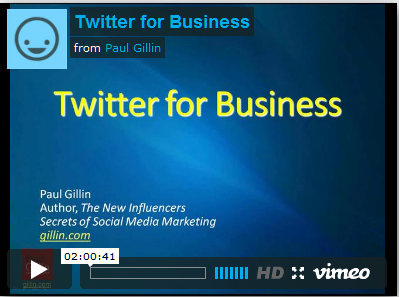Negativity, Social Gaffes and Farewell to Case Studies
I haven’t had a chance to send a newsletter for a few weeks because I’ve been so busy with other assignments. Here’s a sampling of what I’ve been writing about.
Love Your Critics
 The CMO Site likes to stir things up, so my posts there tend to be on the controversial side. In Why Brands Should Love Public Complaints, I make the case that your critics can be your strongest allies. Why? Because a little negativity reinforces the validity of the positive comments you publish.
The CMO Site likes to stir things up, so my posts there tend to be on the controversial side. In Why Brands Should Love Public Complaints, I make the case that your critics can be your strongest allies. Why? Because a little negativity reinforces the validity of the positive comments you publish.
The whole concept of enabling negativity to appear on your own website rubs a lot of marketers the wrong way, but I’d argue that it’s great for building integrity. The article notes that Epson reported that revenue per visitor nearly doubled after it started including customer reviews on its site. The fact that one out of 10 customers may be displeased with your product can be looked at another way: 90% are happy.
The right approach is not to deny that you have unhappy customers; everyone’s got a few. They’re going to vent their frustrations anyway, so encourage them to do it in a place where you can respond and juxtapose their opinions with the vast majority who are pleased.
Read more and comment on The CMO Site
Good Riddance to the Corporate Case Study
In this post, I ranted just a bit about corporate case studies, those pervasive and largely useless vessels of happy talk that no one really believes. Corporate case studies used to have a purpose in the days when customers couldn’t find each other, but today all it takes is a few searches or LinkedIn queries to identify experienced buyers.
It’s not the concept of the case study I don’t like; it’s the format. Once the legal department gets involved in approvals, most meaningful content gets sucked out of the article. Prospective buyers have always viewed case studies with suspicion and I think today they mainly ignore them.
So rather than investing time and dollars paying writers for stories that no one believes, why not focus on greasing the skids between your happy customers and your prospects? Make it easy for the two parties to connect and then get out of the way.
Read more and comment on The CMO Site
The Futility of Whisper Campaigns
 PR practitioners who undertake influencer relations programs often discover an odd disconnect between dealing with bloggers and dealing with traditional media: Bloggers don’t operate by the same rules as reporters.
PR practitioners who undertake influencer relations programs often discover an odd disconnect between dealing with bloggers and dealing with traditional media: Bloggers don’t operate by the same rules as reporters.
The recent example of this disparity ended up embarrassing a prominent PR firm, and I analyzed what went wrong in BtoB magazine.
In case you missed it, early last month a pair of new employees at Burson Marsteller, both of them veteran journalists, contacted a security blogger and offered to help him write and place an op-ed piece that exposed “sweeping violations of user privacy” by Google.
It turns out the blogger was more interested in the motivations of the PR firm than in Google’s allegedly intrusive behavior. After he posted the e-mail exchange online, some USA Today reporters dug up the fact that Facebook was behind the whisper campaign.
Burson, which claims to be social media-savvy, did exactly the opposite of what it would counsel its crisis communications clients to do: It clammed up. The incident was a huge black eye for the agency and a lesson in how not to pitch a blogger.
Read more and comment on BtoBOnline.
Do You Need A Social Media Specialist? Yup.
My most recent column in B2B was actually sparked by a conversation I overheard on a plane. A guy in the seat behind me was railing to his companion about the idiocy of hiring social media specialists. In his opinion, everyone in a company should learn to use the tools. Expertise shouldn’t be concentrated in one person or department.
I agree with his second point but I can’t endorse his overall premise. Nearly every company I’ve encountered that is succeeding in social media has a center of excellence. They aren’t delegating social interactions to one person, but they’re shortcutting the learning process by hiring people who can train others. In this column, I explain why a social media expert can save you time, money and embarrassment (see Burson above).
What’s your approach? Read more and comment on BtoBOnline.
Just for Fun: Weekly World News

WWN was launched in 1979 with the discarded black-and-white presses formerly used by the National Enquirer. It ceased print publication in 2007, but its legacy of informing its readers of the dangers of space aliens, the promise of roadkill diets and the never-ending exploits of the “Bat Boy” continues.
With the tagline of “The World’s Only Reliable News,” Weekly World News has recently reported on alien spaceship attacks coming in November, Southern California’s plans to secede from the union and sightings of mermaids in Israel. One thing is certain: You can’t believe a word of it.





 She would do no such thing. CareOne actually takes a disciplined approach to figuring ROI, she said, using control groups and thousands of data points. Not only do community members convert at dramatically higher rates, but the boost in sign-ups is only one of several business benefits CareOne has realized from its customer community. But more on that in a minute.
She would do no such thing. CareOne actually takes a disciplined approach to figuring ROI, she said, using control groups and thousands of data points. Not only do community members convert at dramatically higher rates, but the boost in sign-ups is only one of several business benefits CareOne has realized from its customer community. But more on that in a minute. CareOne is focusing on the right stuff. The section headlined “CareOne + Social Media: The Measurement” on the
CareOne is focusing on the right stuff. The section headlined “CareOne + Social Media: The Measurement” on the 
 With Nimble, you can import your address book, Facebook and LinkedIn contacts into a single record and associate people’s activities in those networks – as well as Twitter and your inbox – in a single place. So if you’re making a call on a prospect or customer, you can quickly consult the personal or company record to find out what’s been happening in their lives or careers.
With Nimble, you can import your address book, Facebook and LinkedIn contacts into a single record and associate people’s activities in those networks – as well as Twitter and your inbox – in a single place. So if you’re making a call on a prospect or customer, you can quickly consult the personal or company record to find out what’s been happening in their lives or careers. This is the time of year when a lot of people make predictions. I’ll resist that urge, though, and instead present a plea: Let’s make 2011 the year we stop talking about “social media.”
This is the time of year when a lot of people make predictions. I’ll resist that urge, though, and instead present a plea: Let’s make 2011 the year we stop talking about “social media.”
 In
In 
 The
The  If you, like me, regularly use more than one computer to access the Web, you know how frustrating it can be that all browsers are local. You know the drill: You bookmark a website on your home computer and then can’t find the same site when you’re looking for it at work two days later. Or if you use the saved password function in the browser, you learn the hard way that passwords saved on one computer don’t show up on any others unless you copy them through a laborious backup and restore process.
If you, like me, regularly use more than one computer to access the Web, you know how frustrating it can be that all browsers are local. You know the drill: You bookmark a website on your home computer and then can’t find the same site when you’re looking for it at work two days later. Or if you use the saved password function in the browser, you learn the hard way that passwords saved on one computer don’t show up on any others unless you copy them through a laborious backup and restore process. State of the Union addresses aren’t known for their excitement. Especially in an economy like this one. But we found a great idea to spice things up this year:
State of the Union addresses aren’t known for their excitement. Especially in an economy like this one. But we found a great idea to spice things up this year:  It’s okay to admit it. You’re among friends. You’ve been on
It’s okay to admit it. You’re among friends. You’ve been on  Our most recent episode of MediaBlather is an
Our most recent episode of MediaBlather is an 

 What was interesting was the impact these references had on the blog’s visibility. Prior to the reference in BuzzMachine, the site was getting about 500 unique visitors per day. After Jeff Jarvis linked to one of my year-end roundup articles, that average jumped by about 200 visitors a day. It jumped again after the mention in the Economist, eventually settling at about 1,000 average daily visitors, or nearly double its traffic at the beginning of the month. However, a prominent reference in the New Yorker, which is one of the most venerable English-language magazines, had no discernible impact.
What was interesting was the impact these references had on the blog’s visibility. Prior to the reference in BuzzMachine, the site was getting about 500 unique visitors per day. After Jeff Jarvis linked to one of my year-end roundup articles, that average jumped by about 200 visitors a day. It jumped again after the mention in the Economist, eventually settling at about 1,000 average daily visitors, or nearly double its traffic at the beginning of the month. However, a prominent reference in the New Yorker, which is one of the most venerable English-language magazines, had no discernible impact.